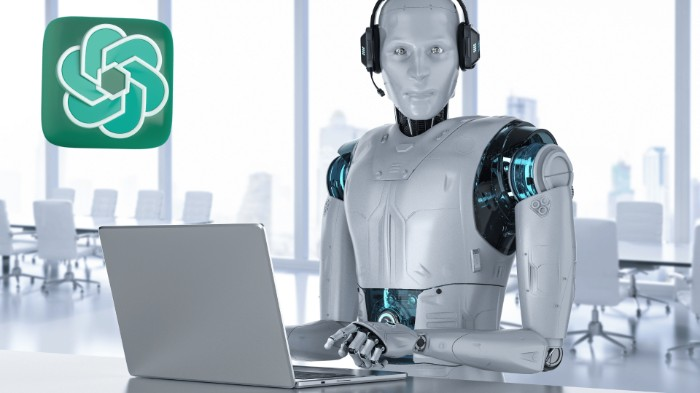Do you know about Chat GPT?
An Introduction to OpenAI’s Conversational AI Model
Imagine being able to have a conversation with a virtual AI assistant that can understand and respond to your questions, just like a human. That’s exactly what Chat GPT does! Developed by OpenAI, ChatGPT is a cutting-edge conversational AI model that’s changing the way we interact with technology.

But what exactly is ChatGPT, and how does it work? If you’re new to the world of AI and have heard the buzz around ChatGPT but don’t know where to start, you’re in the right place. This beginner’s guide will give you a complete introduction to ChatGPT and all its amazing capabilities, making it easy for you to understand this revolutionary technology. So, buckle up and get ready to dive into the exciting world of ChatGPT!
What is Chat GPT?
OpenAI released Chat GPT (Generative Pretrained Transformer) on November 30, 2022, and it’s quickly become one of the leading language models for artificial intelligence. This state-of-the-art AI system is trained on a massive corpus of text to generate convincing human-like responses to prompts. It covers a huge range of internet texts which not only allows it to answer questions promptly but also enables it to produce text that sounds like it was written by a real person. It is truly an impressive piece of technology!
Chat GPT being built on a Transformer model differs from other AI models, such as rule-based systems and decision tree models. Rule-based systems rely on a set of pre-determined rules and do not have the ability to learn and adapt over time. Whereas the Decision tree models can make decisions based on a set of conditions but lack the ability to understand the context and generate coherent language.
Chat GPT, on the other side, goes one step ahead and uses a deep learning approach to generate language based on large amounts of text data. It not only has the ability to understand the context but can also generate comprehensible language. On top of that, It can continue a conversation in a way that resembles human communication.
How Chat GPT Works: Data Science and Artificial Intelligence
ChatGPT is an artificial intelligence chatbot that uses deep neural networks so that it can recognize patterns in data. These networks consist of multiple layers of interconnected nodes, each responsible for analyzing different aspects of the input data.
The specific architecture used by Chat GPT is called a transformer, a type of neural network specifically designed for natural language processing tasks. The transformer architecture allows Chat GPT to analyze the context and meaning of the input text rather than simply recognizing individual words and phrases.
Before it could be used for conversational AI, Chat GPT underwent a pre-training process. This involved feeding the model exponential amounts of text data, allowing it to learn patterns and relationships between words, phrases, and sentences. The ultimate goal of pre-training was to create a model that has a strong understanding of every language and can generate relevant and detailed responses to new input.
Once Chat GPT was trained, it could be used to respond to messages. When it receives a message, it uses the language understanding and patterns it learned during training to come up with a response.
The response is generated by sampling from the probability distribution of possible responses, which is determined by the model’s current understanding of the input and its internal state. The result is a response that is relevant to the input and coherent with the language patterns the model has learned.
Use Cases of Chat GPT
Let’s explore some of the most exciting and innovative use cases for this AI tool.
Chatbots
The technology of ChatGPT has plenty of potential applications across different fields, ranging from customer service and sales to question-answering and content generation. One of these uses is for creating chatbots-software that can communicate in real-time, opening vast amounts of opportunities for all sorts of businesses.
With ChatGPT-powered chatbots, organizations can provide their customers with 24/7 support. Chatbots can come in handy by answering customer queries as well as offering product or service recommendations. It’s no wonder that ChatGPT is quickly becoming a go-to tool for many businesses!
Content generation
With its ability to understand and generate coherent text, Chat GPT can generate various types of content, such as articles, blog posts, fiction, and whatnot. By leveraging its pre-training on vast amounts of text data, Chat GPT can generate relevant and human-like content. This capability can be highly beneficial for a wide range of applications, saving time while producing quality content.
Machine Translation
Machine translation is an invaluable tool that takes text written in one language and quickly and accurately translates it to another. ChatGPT can be used to refine this process even further, providing translations that are more natural, accurate, and understandable.
Text Summarization
Text summarization involves condensing a long piece of text into a shorter, more concise summary that still retains the key information. Chat GPT can be used to generate summaries of text that are both accurate and readable.
Sentiment Analysis
Sentiment analysis refers to the process of automatically determining the sentiment expressed in a piece of text, whether it is positive, negative, or neutral. Chatbot GPT can be used to analyze the sentiment of any text, which can be useful for various applications, such as monitoring brand reputation or gauging public opinion on a topic.
The Future of ChatGPT and Chat Bots
AI technology continues to evolve at a rapid pace, and, likely, Chat GPT will also continue to improve, check out this article on GPT-4. This will possibly include the AI model’s ability to understand and generate text with increased efficiency and speed while eliminating any nonsensical answers or ethical concerns some people may have currently.
This will be good news for all the tech enthusiasts that are already taking advantage of the countless possibilities with this chatbot. With the emergence of new AI technologies, Chat GPT may partner with other AI models to create even more advanced conversational AI systems.
When we look ahead to the future, Chat GPT has a vast range of promising potential uses in many different industries. Already, AI is being used more and more extensively, showcasing just what is possible with Chat GPT going forward.
By leveraging its ability to understand natural language input, generate content, and provide insights through sentiment analysis and text summarization, Chat GPT can open up a world of possibilities that we have yet to fully explore.
Advantages and Limitations of ChatGPT
Here are 7 advantages of ChatGPT:
- Large language models: ChatGPT has been trained on large language models, giving it a deep understanding of human language and enhancing its capability to offer natural responses that resemble human dialogue. This offers users personalized solutions to their problems.
- High accuracy: The AI model has been crafted and trained with the aim of achieving incredibly high accuracy rates. This trait alone makes it perfect for use in customer service and conversation-oriented AI projects!
- Speed and efficiency: ChatGPT quickly and efficiently writes plausible-sounding responses, allowing organizations to save time and resources in tasks such as answering customer inquiries.
- Versatility: With its diverse range of supervised learning applications, the AI model is incredibly versatile. Starting from question-answering to language translation and text generation, this tool can be used across all industries, enhancing processes in no time!
- Cost-effective: Compared to human labour, ChatGPT can be a cost-effective solution for tasks such as customer support and data entry, allowing organizations to save resources.
- Continuous improvement: As ChatGPT is a machine learning model, it can continue to improve and evolve over time as it is trained on new data.
- Scalability: ChatGPT is an incredibly adaptable tool, offering organizations of all sizes trusted and dependable solutions. Its scalability allows for easy personalization to meet the unique needs of each business.
Here are 7 limitations of Chat GPT:
- Bias: Like any machine learning model, ChatGPT has been trained on data that reflects human biases, and these biases can be reflected in its outputs. It is critical to develop strategies for neutralizing biases in the training data.
- Lack of context: ChatGPT does not have a sense of context or memory; therefore, it generates responses solely based on the input it receives. This may restrict its capacity to understand intricate scenarios.
- Limited creativity: While ChatGPT can generate highly accurate responses, it lacks the creativity and original thought of a human, making it unsuitable for certain tasks that require human-like thinking and reasoning.
- Limited knowledge: ChatGPT is trained on a finite amount of data and may not have the latest information on a specific topic. It’s important to consider the knowledge cutoff of the model and whether it has the information needed for a specific task.
- Overreliance on patterns: As a machine learning model, ChatGPT heavily depends on patterns in the data it was trained on. This can result in rigid and formulaic responses, lacking the nuance and empathy of human response.
- Vulnerability to manipulation: Like any AI model, ChatGPT can be manipulated by malicious actors to generate inaccurate or biased responses. When utilizing a model for sensitive tasks, it is absolutely essential to evaluate its security and strength.
- Dependence on high-quality data: The quality of ChatGPT’s responses is heavily dependent on the quality of the data it was trained on. If the training data is biased or inaccurate, this can result in problematic responses from the model.
Conclusion
ChatGPT offers individuals and businesses the potential to create natural conversational experiences. With its large language models, high accuracy rates, speed and efficiency, versatility, scalability, and cost-effectiveness, it is an ideal tool for customer service tasks as well as many other AI applications.
However, it does have limitations such as bias in the training data, lack of context or memory which can restrict its capacity to understand intricate scenarios, and limited creativity when compared to a human response. Despite these drawbacks, ChatGPT remains an impressive AI model that offers individuals and organizations trusted solutions tailored specifically to their unique needs.
FAQs
What is a chatbot?
A chatbot is an AI-powered computer program that can converse with human users, usually anonymously on the web. It relies on natural language processing and machine learning to imitate a real conversation. As if talking to another person, you can interact with the chatbot using questions and statements while it provides answers or instructions in return.
Are chatbots the same as chat GPT?
Absolutely not! Chatbots and ChatGPT are two distinct things. Chatbots are typically designed to answer predetermined questions; however, ChatGPT is an advanced language model that specializes in producing human-like responses to any input.
Can you give an example of how chat GPT can be used in education?
One such example is a virtual tutoring assistant. The model could answer student questions, provide explanations for complex concepts, and even generate practice problems and quizzes.
Can chat GPT generate new ideas?
While ChatGPT has the ability to generate human-like responses to a wide range of inputs, it does not have the creativity or original thought of a human. It can only generate responses based on the patterns and data it was trained on. However, it could be used as a tool to generate ideas and suggestions based on input from a user.
Is ChatGPT better than Google?
Well, it depends on what you mean by “better.” ChatGPT is really good at generating human-like text and answering questions in a conversational manner, but Google is still the king when it comes to searching the web and providing large amounts of information on a wide variety of topics. They both have their strengths and weaknesses, so it’s not really a matter of one being better than the other.










